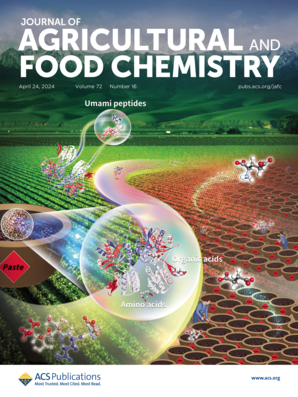Bioaccessible (Poly)phenols of Winery Byproducts Modulate Pathogenic Mediators of Intestinal Bowel Disease: In Vitro Evidence
IF 6.2
1区 农林科学
Q1 AGRICULTURE, MULTIDISCIPLINARY
引用次数: 0
Abstract
Intestinal inflammation entails a multifactorial pathophysiology, frequently treated by using anti-inflammatory drugs with severe side effects. At the same time, bioactive compounds present in plant materials and derived residues could contribute to reducing the use of such medications in terms of dosage and treatment length. Thus, the phytochemicals of winery byproducts, mainly represented by (poly)phenols, display significant anti-inflammatory and antioxidant potential. However, the functionality of bioaccessible fractions remains underexplored. This study uncovers the capacity of bioaccessible (poly)phenols of winery byproducts to modulate inflammatory mediators and secondary oxidative stress (OS). After in vitro simulated digestion, bioaccessible (poly)phenols exhibited significant inhibitory capacity of nitric oxide, interleukin (IL)-6, IL-8, and TNF-α production and prevented OS, lowering reactive oxygen species (ROS) resulting from disturbed cell metabolism while preserving the molecular machinery of cells, involving glutathione, catalase, superoxide dismutase, and glutathione peroxidase. The results retrieved suggested the relevance of specific profiles for efficiently preventing inflammation.

酒庄副产品的生物可及(多)酚调节肠道疾病的致病介质:体外证据
肠道炎症涉及多因素病理生理学,通常通过使用具有严重副作用的抗炎药物来治疗。与此同时,植物材料及其残留物中的生物活性化合物有助于减少此类药物的用量和治疗时间。因此,以(多)酚为主要代表的酿酒副产品中的植物化学物质具有显著的抗炎和抗氧化潜力。然而,生物可获取馏分的功能仍未得到充分开发。本研究揭示了酿酒副产品中的生物可获取(多)酚调节炎症介质和继发性氧化应激(OS)的能力。在体外模拟消化后,生物可(多)酚对一氧化氮、白细胞介素(IL)-6、IL-8 和 TNF-α 的产生具有显著的抑制能力,并能防止 OS,降低细胞代谢紊乱产生的活性氧(ROS),同时保护细胞的分子机制,包括谷胱甘肽、过氧化氢酶、超氧化物歧化酶和谷胱甘肽过氧化物酶。研究结果表明,特定的配置文件对有效预防炎症具有重要意义。
本文章由计算机程序翻译,如有差异,请以英文原文为准。
求助全文
约1分钟内获得全文
求助全文
来源期刊
CiteScore
9.90
自引率
8.20%
发文量
1375
审稿时长
2.3 months
期刊介绍:
The Journal of Agricultural and Food Chemistry publishes high-quality, cutting edge original research representing complete studies and research advances dealing with the chemistry and biochemistry of agriculture and food. The Journal also encourages papers with chemistry and/or biochemistry as a major component combined with biological/sensory/nutritional/toxicological evaluation related to agriculture and/or food.

 求助内容:
求助内容: 应助结果提醒方式:
应助结果提醒方式:


